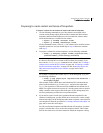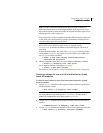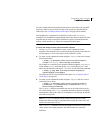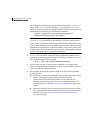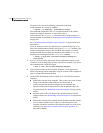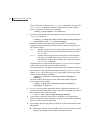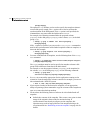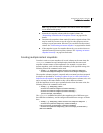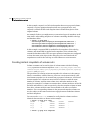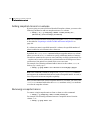
329Administering volume snapshots
Creating instant snapshots
■ Dissociate the snapshot volume entirely from the original volume. This
may be useful if you want to use the copy for other purposes such as
testing or report generation. If desired, you can delete the dissociated
volume. See “Dissociating an instant snapshot” on page 340 for details.
■ If the snapshot is part of a snapshot hierarchy, you can also choose to
split this hierarchy from its parent volumes. See “Splitting an instant
snapshot hierarchy” on page 341 for details.
Creating and managing third-mirror break-off snapshots
Note: Break-off snapshots are suitable for write-intensive volumes, such as
database redo logs.
To turn one or more existing plexes in a volume into a break-off instant
snapshot volume, the volume must be a non-layered volume with a mirror or
mirror-stripe layout, or a RAID-5 volume that you have converted to a
special layered volume (see “Using a DCO and DCO volume with a RAID-5
volume” on page 277) and then mirrored. The plexes in a volume with a
stripe-mirror layout are mirrored at the subvolume level, and cannot be
broken off.
The attributes for a snapshot are specified as a tuple to the
vxsnap make
command. This command accepts multiple tuples. One tuple is required for each
snapshot that is being created. Each element of a tuple is separated from the
next by a slash character (/). Tuples are separated by white space.
To create and manage a third-mirror break-off snapshot
1 To create the snapshot, you can either take some of the existing ACTIVE
plexes in the volume, or you can use the following command to add new
snapshot mirrors to the volume:
# vxsnap [-b] [-g diskgroup] addmir volume [nmirror=N] \
[alloc=storage_attributes]
By default, the vxsnap addmir command adds one snapshot mirror to a
volume unless you use the nmirror attribute to specify a different number
of mirrors. The mirrors remain in the SNAPATT state until they are fully
synchronized. The
-b option can be used to perform the synchronization in
the background. Once synchronized, the mirrors are placed in the
SNAPDONE state.
For example, the following command adds 2 mirrors to the volume, vol1,
on disks mydg10 and mydg11:
# vxsnap -g mydg addmir vol1 nmirror=2 alloc=mydg10,mydg11



